
 MicroLabs - Effective, hands-on experiments. Double click on any word to get a definition. Click here to instantly bookmark MicroLabs.
MicroLabs - Effective, hands-on experiments. Double click on any word to get a definition. Click here to instantly bookmark MicroLabs.
1. Time Estimation
 |
Can you tell exactly how long a minute is without using a clock? Estimate how long one minute is by keeping your eyes closed for one minute. Record your result. Try it again. Did your estimate improve the second time? Why or why not? Compare your results to others.
MATERIALS: Clock
(TOC)
|
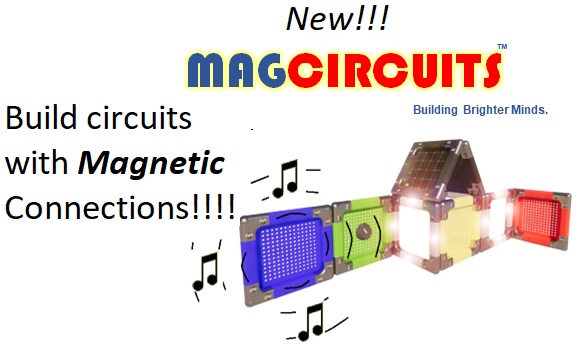
2. A "Staple" of Science
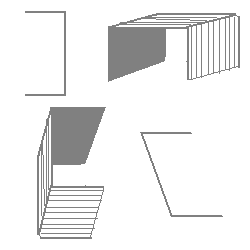 |
What is the mass of a single staple? a single staple in your hand and estimate it's mass. Use a pan balance to measure the mass of the staple. Hint: measure the mass of 20 staples. Record your results. Does your estimate compare to your results? Explain.
MATERIALS: Staple; Pan balance; calculator.
(TOC)
|
3. Height Prediction
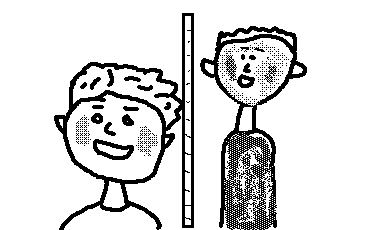 |
Measure the height of three people to the nearest 0.1 cm. Measure the length of the feet of the three people to the nearest 0.1 cm. Make a graph of foot length versus height. Predict how tall a person would be that had a foot length 2.0 cm longer or shorter than your tallest person. Try to find a person that matches your prediction. How close was your prediction?
|
4. Floppy Volume
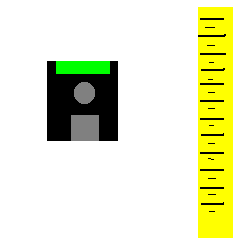 |
Does a floppy disc have a volume of more or less than 10 cm cubed? closely at the markings on a cm scale. Estimate the volume of a floppy disc to one significant digit. Record your estimate in correct scientific notation. Use the cm scale to measure the volume of a floppy disc. Record your results. Compare your estimate to the results.
MATERIALS: Floppy disc; 30 cm ruler; calculator.
(TOC)
|
5. Runner's Speed
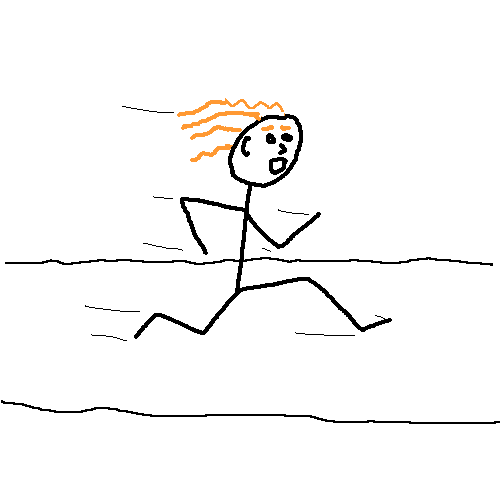 |
Take a stopwatch and a meter stick to a running track or sidewalk. Use the meter stick to measure 20 m. Mark the distance with pieces of masking tape. the time it takes to walk 20 m. Calculate your average speed. Measure the time it takes you to jog, or run, the same distance. What is your average speed?
Materials:stopwatch; Meter stick; Masking tape.
(TOC)
|
(TOC)
6. Ramp Race
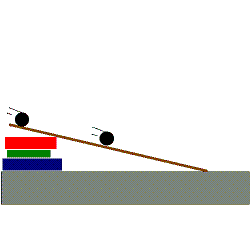 |
an inclined ramp from a piece of U-channel, or two meter sticks taped together along the edges. Mark a position 40 cm and 80 cm from the top. Start one ball at the 80 cm and one at the 40 cm mark. When the balls are released at the same time, will the balls get closer together or farther apart? Why? Try it. Explain what happened in terms of the velocities. What does this tell you about the acceleration of each ball? Retry the experiment but release the ball at the 40 cm mark after the 80 cm ball has rolled half way down. Do the balls stay the same distance apart? Do they have the same acceleration?
Materials: U-channel; books; meter stick; 2 steel balls.
(TOC)
|
7. Balanced vs. Unbalanced Forces
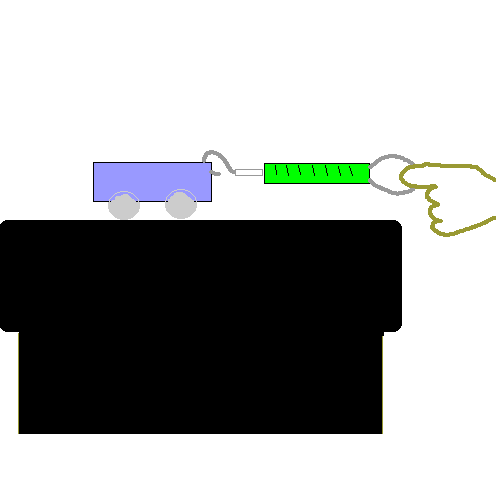 |
Attach a 1 kg cart to a spring scale and pull horizontally on the scale so it moves at a slow, steady speed. What was the value on the spring scale? Were the forces balanced? Repeat the procedure except try to keep the reading on the balance at a constant value of 2.0 N. Describe the motion. Were the forces balanced or unbalanced? Explain.
Materials:,1 kg cart; spring balance.
(TOC)
|
(TOC)
8. Force Vectors
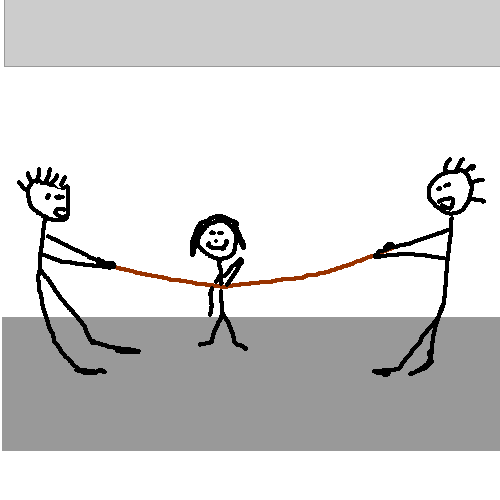 |
Ask two classmates to pull on the opposite ends of a strong 5 m long rope. Does the rope appear to be straight? Now push down on the middle of the rope with one finger. Is it possible for the students to keep the rope taut and straight? Explain.
Material: 10 m rope.(TOC)
|
(TOC)
9. Force Vectors Returns
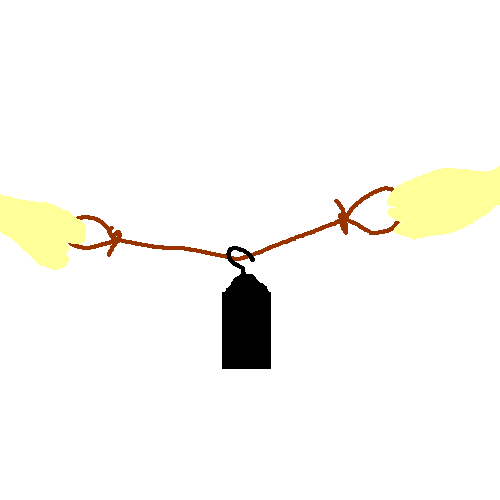 |
Tie two loops in the ends of a strong cord that is about 1 m long. Hold a loop in each hand as a classmate carefully hangs a 1 kg mass on the cord. Start with your hands together and slowly move your hands apart. Try to make the cord straight. Is it possible? In what direction are the forces acting?
Material: 1 m cord; 1 kg mass.(TOC)
|
(TOC)
10. Projectile Motion
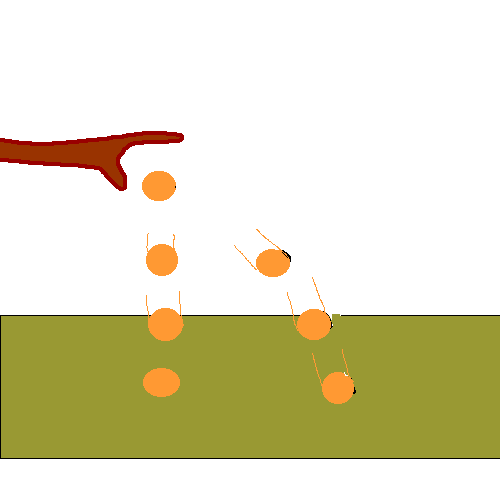 |
Place a super ball or golf ball in your hand and extend your arm sideways so the ball is at shoulder height. Drop the ball and have a lab partner start a stopwatch when the ball strikes the floor and stop it the next time the ball strikes the floor. If you repeat the experiment when you walk at a steady speed, where would you expect the ball to hit? Would the ball take the same time to bounce? Give it a try.
Materials: golf ball; stopwatch.(TOC)
|
(TOC)
11. Pendulum
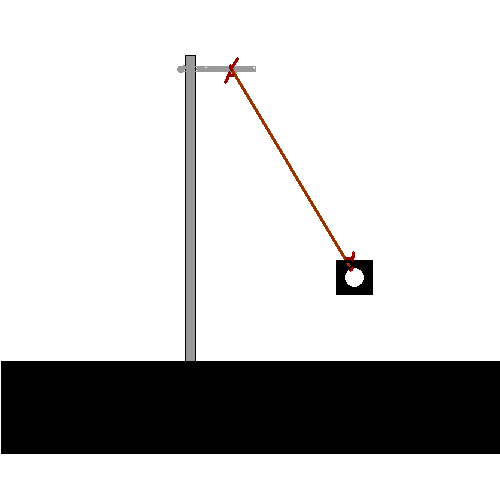 |
the pendulum equation for the length needed for a pendulum with a period of 1.00 s. Use a piece of string and a steel nut to build the pendulum. Test your pendulum for 10 complete swings. Materials: 1.0 m string: steel nut.(TOC)
|
(TOC)
12. Coupled Pendulum
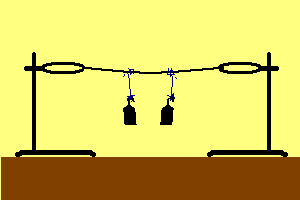 |
Stretch and tie a string between two ring stands. Hang two 50 g hooked masses from two equal length strings that are tied to the horizontal string. Pull one of the masses back a little and let it swing back and forth. What happened to the other mass? Explain your results.Materials: Two ring stands, string, two 50 g masses(TOC)
|
(TOC)
13. Free-fall
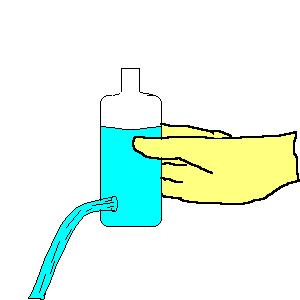 |
Poke a hole in the bottom of a plastic water bottle. Fill the bottle 3/4 full of colored water. Drop the bottle into a container. What happened to the water as it fell? Why?
Materials:Water bottle, water, food coloring.
(TOC)
|
(TOC)
14. Apparent Weightlessness
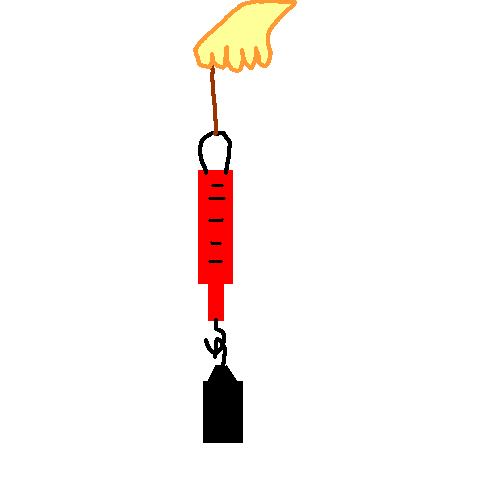 |
Tie a string to the top of a spring scale. Hang a 0.1 kg mass on the bottom of it. Hold the scale in your hand. Observe the weight of the mass. What will the reading be when the string is released? Why? Give it a try. Materials:string; spring scale; 0.1 kg mass. (TOC)
|
(TOC)
15. Impulse Momentum
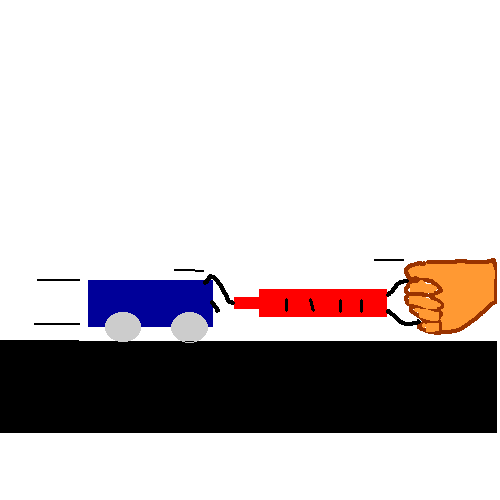 |
Attach a spring scale to a laboratory cart. First, pull the cart for 1.0 s exerting 1.0 N of force. Second, pull the cart for 2.0 s exerting about 0.5 N of force. Predict which trial will give the cart more acceleration. Explain. Predict which trial will give the cart more velocity. Explain. Try it. What happened? Which factor, F or time, seems to be more important in changing the velocity of the cart?
Materials: dynamic cart; stopwatch; spring scale. (TOC)
|
(TOC)
16. Work-Out
|
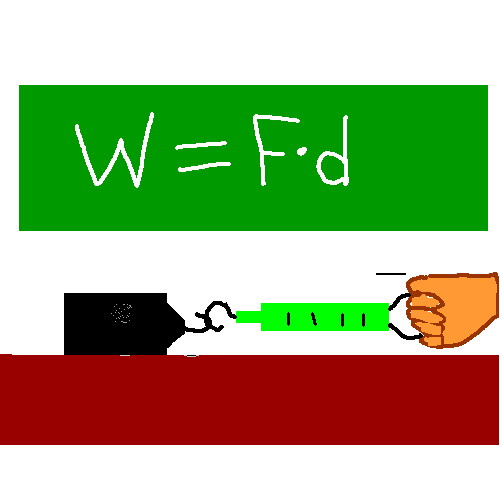 |
a spring scale to a 1.0 kg mass. Pull the mass along the table at a slow, steady speed keeping the scale parallel to the table top. What is the average reading on the spring scale? What determines the amount of force needed? How much work is done in moving the mass 2.0 m? Predict the force and the work when 2.0 kg is pulled along the table.Give it a try. How accurate was your prediction?
Materials: spring balance; 1.0 kg mass (TOC)
|
(TOC)
17. Power Run
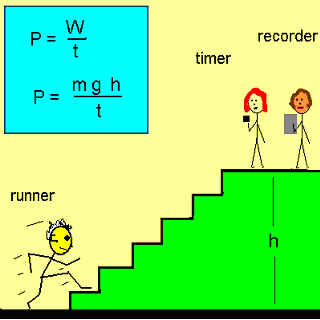 |
How much horsepower does a person have? Measure (or convert - 1 kg = 2.2 lbs) and record the mass of the runner in kilograms. Measure the height of one step and multiply by the number of steps to find the total height of the staircase. Record. Predict the power of your runner.Measure and record the time it takes the runner to quickly and carefully climb the stairs. Find the work done in climbing the stairs. Calculate the power (in Watts) in climbing the stairs. Convert the power in watts to horsepower (1 hp = 746 watts). How accurate was your prediction?
Materials: meter stick, stopwatch, stairs
(TOC)
|
(TOC)
18. Efficiency
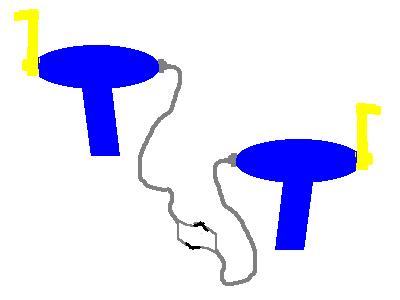 |
What is the efficiency of a generator? Hook two hand-generators together. Turn the handle on one generator (the input) 10 revolutions while a classmate counts the revolutions on the other (the output). Divide the output revolutions by the input revolutions and then multiply by 100. What was your efficiency? Was your generator system 100% efficient? Why or why not? Explain.
Materials: Two hand-generators
(TOC)
|
19. Floating or Surface Tension?
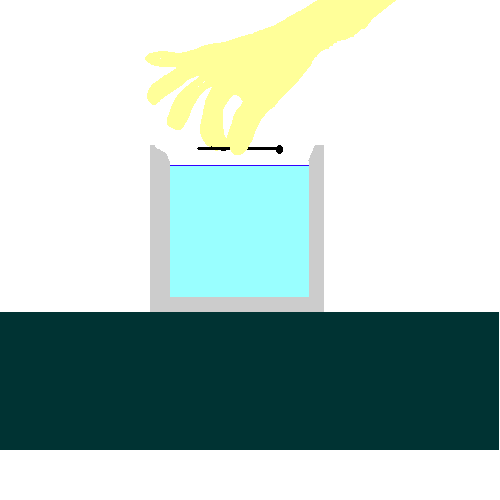 |
a glass or beaker 7/8 full of water. Gently place a needle on the surface of the water. Try to "float" it. Try to "float" a paper clip. Try to "float" a coin. Explain the results.
Materials: beaker; water; needle; paper clip; coin. (TOC)
|
(TOC)
20. Bernoulli's Principle
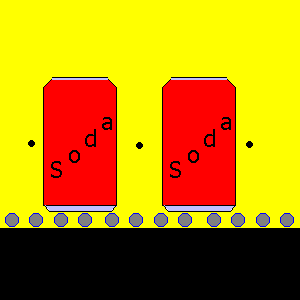 |
Place two empty soda pop cans 2 cm apart on drinking straws that are spaced about 1 cm apart. Blow a gust of air in between the cans. What happened? Reset the cans and blow on the right-hand side of the can on the right. What happened? Repeat on the left-hand side of the left can. What happened this time? Explain your results.
Materials: Two empty soda pop cans; one dozen drinking straws(TOC)
|
(TOC)
21. Upside Down
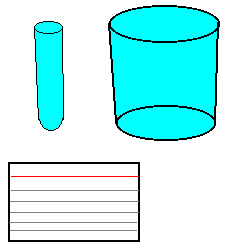 |
Can a 3 x 5 card hold water in glass of water thatis turned upside down? a glass or beaker full of water. Gently place a 3 x 5 card on the surface of the water. Over a sink, hold the 3 x 5 card on the glass and turn it upside down. What happed? Try this again with a test tube. Explain what happened.
Materials: beaker; water; test tube; 3 x 5 cards. (TOC)
|
(TOC)
22. Flask Fun!
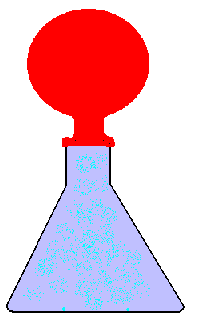 |
Heat a few ml of water in aflask to boiling. Stretch an un-inflated balloon over the mouth of theflask. Let the flask cool. What happened? Explain. Placethe flask on the hotplate and let the water boil again
. What happened? Explain.
Materials: 250 ml Erlenmeyer flask, balloon, hotplate.
(TOC)
|
(TOC)
23. Cooling Curves
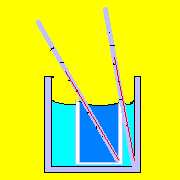 |
Place a 100 ml beaker inside a 250 ml beaker. Place a thermometer in each beaker. Fill the small beaker with hot, colored water. Determine the temperature of the colored water. Slowly pour cold water into the 250 ml beaker until the water is the same height in both beakers. Record the temperature in the 250 ml beaker. Record the temperature in both beakers every 30 sec for 5 minutes. Plot your data for both beakers on the same graph with temperature on the vertical axis and time on the horizontal. Describe each curve. Are they the same? Predict what the temperature will be after 10 minutes, 20 minutes and one day.
Materials: 100 ml beaker; 250 ml beaker; hot and room temperture water; stopwatch; 2 thermometers. (TOC)
|
(TOC)
24. Fluid-Heat
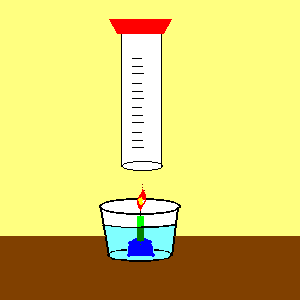 |
Use clay to hold a birthday candle in the bottom of a cup that is halfway filled with water. Light the candle and place an upside down graduated cylinder over the candle and into the surface of the water. What happened? Explain your results.
Materials: birthday candel, lump of modeling clay, clear plastic cup or beaker, graduated cylinder, water, matches. (TOC)
|
(TOC)
25. CocaCalorimeter
 |
Which has more calories, a dry roasted peanut or a potato chip? To find out, pour 100 ml of water into an empty pop can. Suspend the pop can from a ring stand. Place a dry-roasted peanut on a pin and hold under the pop can. Light with a match and hold the peanut under the pop can until it stops burning. Did the water change in temperature? How much? Record the change in temperature of the water and determine the energy (J) that was stored in the peanut. Repeat with the potato chip and compare.
Materials: 100 ml graduated cylinder; ring stand; water; thermometer; pin; peanut and potato chip. (TOC)
|
(TOC)
26. Mechanical to Thermal Energy
 |
10 g of water in a small graduated cylinder. Wrap 10 cm of nichrome wire around the bulb of a thermometer and place in the bottom of the graduated cylinder. Use a spring scale to measure the force needed to turn the crank on the genecon. Record the force. Use a ruler to measure the lever-arm length, and record. How many revolutions are needed to raise the temperature of the water 5 degrees celsius. Try it. Calculate the change in thermal energy of the water. Calculate the mechanical energy needed. Compare the mechanical and thermal energy. Are they the same? If not, where did the missing energy go?
Materials: Thermometer; water; graduated cylinder; genecon; nichrome wire; ruler.
Genecon
(TOC)
|
(TOC)
More>>
Copyright ©2000 - 2004 by PhysicsLessons.com
If you have any suggestions, questions or comments email us!

![]() MicroLabs - Effective, hands-on experiments. Double click on any word to get a definition. Click here to instantly bookmark MicroLabs.
MicroLabs - Effective, hands-on experiments. Double click on any word to get a definition. Click here to instantly bookmark MicroLabs.

























